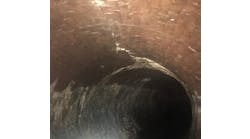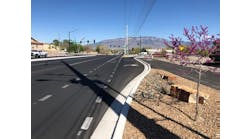Managing storm water runoff from one of the most environmentally sensitive and largest public works projects in the region is a challenge at the Seattle-Tacoma (Sea-Tac) International Airport in the state of Washington.
Developers are bringing in 6 million cu yd of fill material to create the embankment needed for a new, third runway. Quietly and effectively, the latest technology available in managing storm water is assuring that construction runoff meets stringent state regulations.
The port of Seattle, responsible for the $1.1 billion Third Runway Project, considers storm water runoff as one of the project’s most critical environmental issues.
The port and the project general contractor chose Natural Site Solutions (NSS) as the project’s storm water management consultant. NSS specializes in water filtration using chitosan, a 100% biodegradable biopolymer derived from crab and shrimp shells, to enhance coagulation of sediment particles in turbid water for subsequent gravity settling, biofiltration, sand filtration or cartridge filtration.
Craig Carlson, a senior water-treatment specialist with NSS, explained that the monitoring solution needed for this high-visibility project required continuous monitoring of turbidity and pH in discharge to local streams.
“Turbidity, in particular, is significant and must average no more than 5 NTU over a 24-hour period. In addition to the state requirements, we needed to automate the monitoring of incoming runoff to optimize treatment performance. Discharge management required nothing short of the highest-quality instrumentation and the utmost in reliable system performance.”
NSS contacted Rain for Rent, a company that specializes in the development of water-handling solutions.
Paul Reilly, manager of the Rain for Rent filtration and separations division, described the on-site portable water-quality monitoring system developed to answer the challenge.
Compact monitoring and treatment
According to Reilly, on-site containment ponds collect up to 10 million gal or more of runoff via natural drainage after a rain event. A settling period of 24-48 hours, depending on weather conditions, usually reduces turbidity to less than 600 NTU.
A fully automated, vacuum-assisted Power Prime Pump from Power Prime, a sister company of Rain for Rent, transfers runoff to the portable water-quality monitoring system, which includes an internal piping system, flocculent storage, injection pumps, thermostatically controlled heating elements and 110-volt power outlets.
Rain for Rent installed pHD differential-method pH sensors and SOLITAX sc Turbidity and Suspended Solids Sensors from Hach Co. as part of the system to continuously measure turbidity and pH and send readings to a Hach sc100 Controller for display and recording.
Based on current influent turbidity measurements displayed by the controller, operators adjust dosing of the chitosan flocculent to optimize treatment. A second pair of pHD and SOLITAX sensors monitor effluent from the sand-media filters, which typically exhibits turbidity of 1 to 3 NTU and pH of 6.7 to 7.4. “The automation of this system is attributable to the sensor controllers that send a signal to a set of control valves in the monitoring system to direct the storm water appropriately,” explained Reilly. “If influent is within prescribed turbidity and pH criteria for treatment, the sensor controller directs it to the sand filters. If influent exceeds those criteria, the sensor controller diverts it back to the retention structure. “Similarly, sensor controller monitoring filter effluent diverts all storm water that doesn’t meet discharge requirements back for repeat treatment. In case of a power failure, the system automatically diverts all storm water back to the source to maintain compliance until power is restored.”
Carlson added, “This automation assures that storm water leaving the site is in compliance, and at the same time it protects the filters and significantly reduces cleaning and servicing.”
Reilly noted, “The monitoring system also is equipped with audible and visual alarms for an extra degree of protection for the client.”
System proves durable
Seven units of the Portable Water Quality Monitoring System are located over 180 acres of the Third Runway area. From installation in September 2004—the beginning of the rainy season—to the beginning of April 2005, these systems have handled about 60 million gal of runoff prior to discharge to local steelhead streams. Monitoring will continue through the end of 2005 when the embankment phase of the Third Runway Project is scheduled for completion.
According to Carlson and Reilly, their respective firms largely credit the in-line pH and turbidity sensors and controllers for the high level of performance of the portable water-quality monitoring system.
“We haven’t had one of the sensors fail since initial deployment,” affirmed Carlson.
Reilly agreed, “They are truly industrial-strength instruments.” Carlson noted that, through a field service support agreement, a factory representative visits the site to assure proper sensor calibration and performance. He continued, “A further benefit of the monitoring system is that the universal controller records and documents readings from both sensors every five minutes. These data points are then downloaded weekly to a PDA via the infrared port on the controller for management reports prepared by Natural Site Solutions for the Washington Department of Ecology.”
“The entire system has demonstrated tremendous reliability and a significant savings in manpower,” concluded Reilly, who explained that Rain for Rent has begun the patent application process for this powerful yet simple system.


